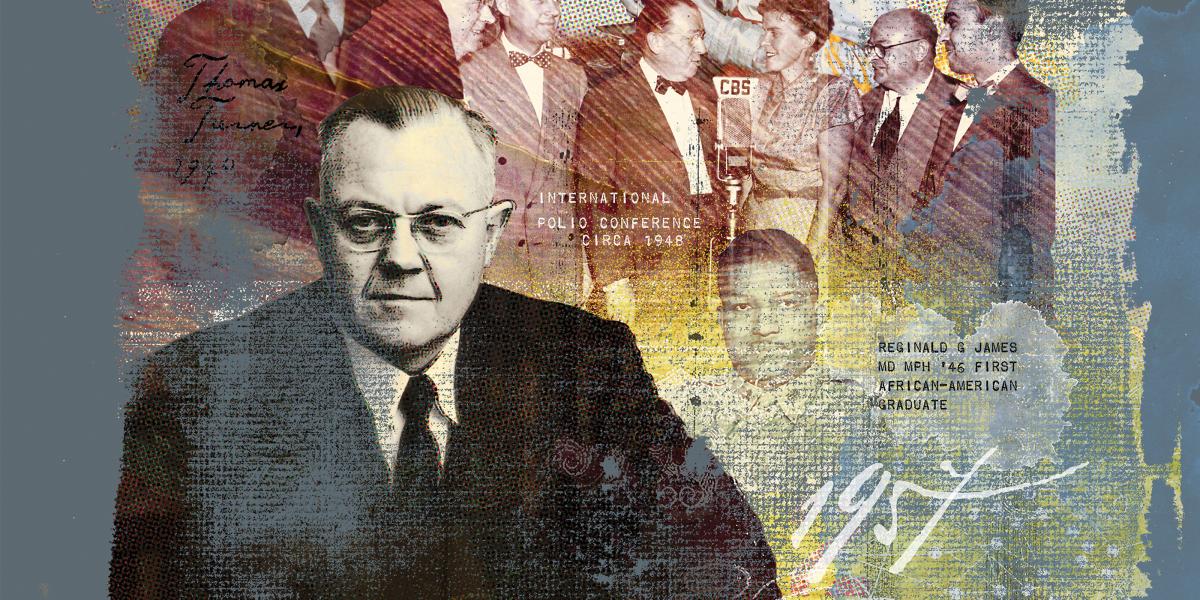Stebbins Saves the School and the MPH
Turning Points | Four defining moments in the history of the Bloomberg School
In an era of grand crusades—against syphilis, polio and totalitarianism—Ernest L. Stebbins, MPH ’32, was a public health star. As New York City Health Commissioner during World War II, Stebbins ran the nation’s largest public health unit, serving 7.5 million people. In 1946, Stebbins, 44, became the youngest dean ever appointed at the School, and the first to hold a master of public health. Stebbins led JHSPH for 21 years, until 1967, and remains its longest-serving dean. The last dean to also chair a department, Stebbins made Public Health Administration an engine of growth and innovation that showcased the best new methods in public health teaching and practice.
Yet the 1950s posed challenges that threatened the school’s very survival. Although externally funded research grew rapidly, JHSPH’s deficit also grew as enrollments increased while endowment income and general operating funds stagnated. By 1955, the university’s entire deficit was in the Medical Institutions, prompting leaders to scrutinize duplication between Hygiene and Medicine.
Basic science at Johns Hopkins had long enjoyed a privileged status, which was challenged by the perception (but not the reality) that infectious diseases such as malaria, syphilis, polio and tubercu losis had been all but conquered. The school had been a “magic bullet factory,” producing and/or evaluating many of the century’s most powerful tools and tests for preventing disease in populations, such as vitamin D, penicillin, DDT, antimalarial drugs, the TPI test for syphilis, and the diphtheria–pertussis–tetanus (DPT) and Salk polio vaccines. The shift away from a singular emphasis on infectious and parasitic disease—“bugs and drugs”—and toward a less binary, more multicausal understanding of health and illness as a continuous spectrum was akin to the postwar conversion of defense production to a diversified peacetime economy.
In 1957, as Johns Hopkins trustees considered downgrading JHSPH to become a medical school department, Thomas Turner chaired the school’s first internal self-study of its educational objectives. Turner, chair of Microbiology, called the MPH “a cheaply earned degree” that attracted “a few good students, a large group of mediocre students, and too many poor students [who absorbed] an undue amount of faculty energy.” In return, MPH students complained that the microbiology requirement was “too detailed, too mechanical and too unproductive in developing the student’s thinking.”
The Turner Committee recommended jettisoning the MPH in favor of emphasizing the DrPH with a strengthened research emphasis. Yet the loss of MPH tuition revenues could potentially sink the school’s finances. The report’s most controversial conclusion was that “The medical sciences constitute the core of public health and preventive medicine. The School of Hygiene, therefore, should draw closer to the School of Medicine and Hospital, in view of the increasing importance of cardiac, mental and malignant diseases.” Some faculty, including parasitologist Lloyd Rozeboom, said this would “lead to dimming of the public health objectives, and submergence of the School of Hygiene into the research program of the medical school.” After Turner became dean of the School of Medicine in mid-1957, many basic science faculty followed him, but the MPH was spared.
As president of the Association of Schools of Public Health, Stebbins enlisted Senator Hubert Humphrey to help pass federal programs that rescued JHSPH from fiscal disaster by using defense concerns to stimulate funding for public health research and training. The 1958 Hill-Rhodes Public Health Professional Training Act provided scholar- ships for 60 percent of graduate public health students for the next 20 years. The International Health Research Act of 1960, or “Health for Peace,” reinvigorated programs under an array of federal agencies that would support an international health research boom across JHSPH.
-
1942
JHSPH and the School of Medicine establish a training program for Army medical officers.
-
1943
Margaret Merrell is chief statistician for the landmark trial evaluating penicillin treatment of syphilis.
-
1946
Federal and international public health funding dramatically increases JHSPH enrollment.
-
1950
Anna Baetjer establishes that chromate dust exposure causes lung cancer in chromium industry workers.
-
1950
Physiological Hygiene is reestablished as Environmental Medicine, the first joint Medicine-Hygiene department.
-
1951
Alexander Langmuir establishes the Epidemic Intelligence Service to train field epidemiologists.
-
1952
Thomas Turner, chair of Bacteriology, renames the department Microbiology.
-
1953
JHSPH dean emeritus Lowell Reed is appointed president of Johns Hopkins University.
-
1953
JHSPH-based Commission on Chronic Illness begins landmark epidemiological surveys of chronic disease.
THE WAR YEARS
During World War II, the federal budget increased to 10 times its peacetime level. JHSPH participated in the wartime campaigns against syphilis, polio, typhus and malaria, and developed new methods for scientific research, vector control and disease prevention that became prototypes for national and international programs. By 1945, JHSPH was poised to bring a public health perspective into the newly reorganized and expanded National Institutes of Health. The war also provided the political will and funding to make the Master of Public Health the standard mark of professional competence for public health practitioners by 1950.
